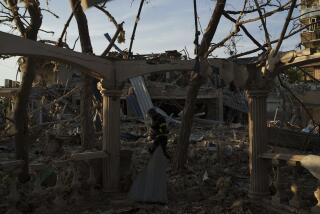Reporters Get a Tour of Remnants of Iraqi Town
- Share via
DIWANIYAH, Iraq — For Said Ahmed Mohammed, Jan. 17 is a date to remember: His job disappeared along with the 73-room hotel he managed in the business district of Diwaniyah.
The area came under heavy bombardment on the first day of the Persian Gulf War. Two waves of attacking aircraft turned into rubble most buildings along two streets near the telecommunications building, apparently the main target of the raid.
“They bombed without mercy,” said Mohammed, a 46-year-old Egyptian. “They hit the hotel, full of families, and then they came back to hit it again.”
Mohammed was speaking to reporters taken Saturday to Diwaniyah, 110 miles south of Baghdad, by officials of the Ministry of Information who wanted them to see that American bombs were hitting residential areas as well as military targets.
According to Mohammed, who was general manager of the Al Yarmuk Hotel, 11 people died in the rubble of the building and 49 were wounded.
“Four turned insane because of fright, because of the loud voices of the bombs,” he said.
According to local officials, Diwaniyah came under attack three times--Jan. 17, Jan. 20 and again last Thursday.
They said the total death toll of civilians was 35. There was no way of confirming this figure.
The Al Yarmuk Hotel stood in the center of the business district, flanked by shops and kebab restaurants.
“Why did they do that?” asked Saeed Jaber, a trader in his 50s. “This hotel had no military people in it. Neither had my shop next to it. (President) Bush says his planes are hitting only military targets. He is lying.”
What happened to the Diwaniyah business district is known in military terms as “collateral damage”--civilian deaths and injuries as a side effect of war.
It is not known how much collateral damage has been caused by thousands of allied air strikes on Iraq since the war began. Iraqi authorities have not released total casualty estimates--partly because there are no communications among the major cities.
Besides the business district, reporters saw a residential area and were shown three deep craters, filled with water from recent rains, where once there had been houses.
Residents said the houses had been wiped out in an air strike on the first day of the war. They gave conflicting casualty figures, with nine dead the most frequently mentioned. Three of the victims were said to have been children.
Across the street, a large factory complex with a camouflaged roof was turned into a tangle of steel and broken walls. Local officials described the factory complex as a flour mill and grain warehouse. A number of 110-pound sacks of grain and rice--including several labeled “Product of the United States”--stood in one corner of a ruined building.
Before the attacks, high-tension power lines ran above the complex. On Saturday, they hung down like strands of spaghetti.
The trip south from Baghdad to Diwaniyah led past scenes that have barely changed since the days when Iraq was Mesopotamia--the “land between rivers,” the Tigris and Euphrates. Boys rode on donkeys, cattle wandered slowly through the desert and women washed clothes in rivers.
This report was reviewed by Iraqi censors.
More to Read
Sign up for Essential California
The most important California stories and recommendations in your inbox every morning.
You may occasionally receive promotional content from the Los Angeles Times.












